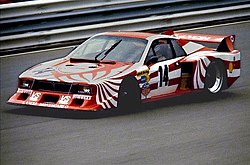2nd Generation Group 5 - "Sports Cars" (1970 to 1971)

For the 1970 season, the FIA applied the Group 5 classification to the Sports Car class which had previously been known as Group 4 Sports Cars. The minimum production requirement remained at 25 and the engine capacity maximum at 5 litres as had applied in the superseded Group 4. Group 5 Sports Cars contested the FIA's International Championship for Makes in 1970 & 1971, alongside the 3 litre Group 6 Prototype Sports Cars.
During 1970 the FIA decided to replace the existing Group 5 Sports Car category when the rules expired at the end of the 1971 season, so the big 917s and 512s would have to be retired at the end of that year. Surprisingly, Ferrari decided to give up any official effort with the 512 in order to prepare for the new 1972 season regulations. But many 512s were still raced by private teams, most of them converted to M specification. As a result of the rule change, sports car racing popularity suffered and did not recover until the following decade, with the advent of Group C which incidentally were forced out of competition in favour of the 3.5 atmo engine formula, reminiscent of events nineteen years previous.
Background to the 5 Litre Sports Car category
In an effort to reduce the speeds generated at Le Mans and other fast circuits of the day by the unlimited capacity Group 6 Prototypes such as the 7 litre Fords, and to entice manufacturers of 3 litre Formula One engines into endurance racing, the Commission Sportive Internationale (then the independent competition arm of the FIA) announced that the new International Championship for Makes would be run for Group 6 Sports-Prototypes limited to 3 litre capacity for the four years from 1968 through 1971.
Well-aware that few manufacturers were ready to immediately take up the challenge, the CSI also allowed the participation of 5 litre Group 4 Sports Cars manufactured in quantities of at least 50 units. This targeted existing cars like the aging Ford GT40 and the newer Lola T70 coupe.
In April 1968, the CSI announced that, as there were still too few entries in the 3 litres Group 6 Prototype category, the minimal production figure to compete in the Group 4 Sport category of the International Championship of Makes would be reduced from 50 to 25 starting in 1969 through to the planned end of the rules in 1971. This was mainly to allow the homologation in Group 4 of cars such as the Ferrari 250 LM and the Lola T70 which had not been manufactured in sufficient quantities to qualify (unless, in the case of the Lola T70, the open Can-Am cars were counted as well).
Starting in July 1968, Porsche made a surprising and very expensive effort to take advantage of this rule. As they were rebuilding race cars with new chassis every race or two anyway, they decided to conceive, design and build 25 versions of a whole new car for the Sport category with one underlying goal: to win its first overall victory in the 24 Hours of Le Mans. In only ten months the Porsche 917 was developed, based upon the Porsche 908, with remarkable technology: Porsche's first 12-cylinder engine, and many components made of titanium, magnesium and exotic alloys that had been developed for lightweight hillclimb racers. Other ways of weight reduction were rather simple, like a gear lever knob made of Balsa wood.
When Porsche was first visited by the CSI inspectors only three cars were completed, while 18 were being assembled and seven additional sets of parts were present. Porsche argued that if they assembled the cars they would then have to take them apart again to prepare the cars for racing. The inspectors refused the homologation and asked to see 25 assembled and working cars.
On April 20 Ferdinand Piëch displayed 25 917s parked in front of the Porsche factory to the CSI inspectors. Piëch even offered the opportunity to drive one of the cars, which was declined.
During June 1969, Enzo Ferrari sold half of his stock to FIAT, and used some of that money to do what Porsche did 6 months earlier with the 917, to build 25 cars powered by a 5-litre V12 in order to compete against them. With the financial help of Fiat, that risky investment was made, and surplus cars were intended to be sold to racing customers to compete for the 1970 season. Within 9 months Ferrari manufactured 25 512S cars.
Ferrari entries only consisted of the factory cars, tuned by SpA SEFAC and there were the private cars of Scuderia Filipinetti, N.A.R.T., Écurie Francorchamps, Scuderia Picchio Rosso, Gelo Racing Team and Escuderia Montjuich which not receive the same support from the factory. They were considered as field fillers, never as candidate for a win. At Porsche, however, JWA Gulf, KG Salzburg who were then replaced by Martini Racing for the following season, received all direct factory support and the privateers like AAW Shell Racing and David Piper Racing received a much better support than Ferrari's clients.
The 917 instability problem was resolved with a revised rear hatch, which was called 917K (Kurzheck). There was a long tail version known as the 917LH (Langheck). Towards the end of the 1970 season, Ferrari entered some races with a new version of the 512, the 512M which had a revised bodywork






































